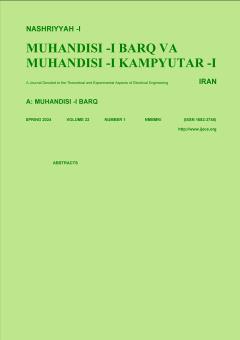Optimal Power Allocation for Maximizing Secrecy Rate in Physical Layer Security Using Frequency Diverse Array Directional Modulation and Artificial Noise
Subject Areas : electrical and computer engineeringMahdi Tayyeb Massoud 1 , Hossein Khaleghi 2
1 - Malek Ashtar University of Technology
2 -
Keywords: Physical layer security, random frequency diverse array, directional modulation, artificial noise, secrecy rate,
Abstract :
The directional modulation is a prominent and practical technique for enhancing the physical layer security in modern communication systems. In this method, the message signal is modulated by an array of antennas and transmitted in a specific direction to the legitimate receiver, such that in other directions, the signal is destroyed and not receivable by eavesdroppers. By incorporating random frequency diverse array directional modulation, secure communication can be achieved in both angular and distance dimensions for the legitimate receiver. However, when the eavesdropper is located near the legitimate receiver, the confidentiality performance of this solution significantly deteriorates. To address this issue, this paper proposes a novel approach that combines artificial noise with random frequency diverse array directional modulation and optimizes power allocation to attain the maximum secrecy rate. Simulation results demonstrate that our proposed approach improves the secrecy rate of the physical layer security by at least one bit per second per hertz compared to the method without artificial noise, and by at least two bits per second per hertz compared to the phased array directional modulation.
[1] X. Chen, D. W. K. Ng, W. H. Gerstacker, and H. H. Chen, "A survey on multiple-antenna techniques for physical layer security," IEEE Communications Surveys & Tutorials, vol. 19, no. 2, pp. 1027-1053, Second Quarter 2016.
[2] Y. Wu, T. Q. Duong, and A. L. Swindlehurst, "Safeguarding 5G-and-beyond networks with physical layer security," IEEE Wireless Communications, vol. 26, no. 5, pp. 4-5, Oct. 2019.
[3] L. J. Rodriguez, et al., "Physical layer security in wireless cooperative relay networks: state of the art and beyond," IEEE Communications Magazine, vol. 53, no. 12, pp. 32-39, Dec. 2015.
[4] C. E. Shannon, "Communication theory of secrecy systems," the Bell System Technical J., vol. 28, no. 4, pp. 656-715, 1949.
[5] A. D. Wyner, "The wire‐tap channel," Bell System Technical J., vol. 54, no. 8, pp. 1355-1387, Oct. 1975.
[6] J. D. V. Sánchez, L. Urquiza-Aguiar, M. C. P. Paredes, and D. P. M. Osorio, "Survey on physical layer security for 5G wireless networks," Ann. Telecommun., vol. 76, no. 12, pp. 155-174, 2021.
[7] F. Shu, et al., "Directional modulation: a physical-layer security solution to B5G and future wireless networks," IEEE Network, vol. 34, no. 2, pp. 210-216, Mar./Apr. 2020.
[8] W. Q. Wang, "DM using FDA antenna for secure transmission," IET Microwaves, Antennas & Propagation, vol. 11, no. 3, pp. 336-345, Feb. 2016.
[9] P. F. Sammartino, C. J. Baker, and H. D. Griffiths, "Frequency diverse MIMO techniques for radar," IEEE Trans. on Aerospace and Electronic Systems, vol. 49, no. 1, pp. 201-222, Jan. 2013.
[10] W. Q. Wang, "Frequency diverse array antenna: new opportunities," IEEE Antennas and Propagation Magazine, vol. 57, no. 2, pp. 145-152, Apr. 2015.
[11] Y. Liu, "Range azimuth indication using a random frequency diverse array," in Proc. IEEE Int. Conf. on Acoustics, Speech and Signal Processing, ICASSP'16, pp. 3111-3115, Shanghai, China, 20-25 Mar. 2016.
[12] Y. Liu, H. Ruan, L. Wang, and A. Nehorai, "The random frequency diverse array: a new antenna structure for uncoupled direction-range indication in active sensing," IEEE J. of Selected Topics in Signal Processing, vol. 11, no. 2, pp. 295-308, Mar. 2017.
[13] N. Yang, et al., "Artificial noise: transmission optimization in multi-input single-output wiretap channels," IEEE Trans. on Communications, vol. 63, no. 5, pp. 1771-1783, May 2015.
[14] M. Ragheb, A. Kuhestani, M. Kazemi, H. Ahmadi, and L. Hanzo, "RIS-aided secure millimeter-wave communication under RF-chain impairments," IEEE Trans. on Vehicular Technology, vol. 73, no. 1, pp. 952-963, Jan. 2023.
[15] R. Dong and F. Shu, Power Allocation and Beamforming Design for IRS-Aided Secure Directional Modulation Network, arXiv preprint arXiv:2312.15504, 2023.
[16] S. Wan, et al., "Power allocation strategy of maximizing secrecy rate for secure directional modulation networks," IEEE Access, vol. 6, pp. 38794-38801, 2018.
[17] J. Hu, F. Shu, and J. Li, "Robust synthesis method for secure directional modulation with imperfect direction angle," IEEE Commun. Lett., vol. 20, no. 6, pp. 1084-1087, Jun. 2016.
[18] S. S. Rao, Engineering Optimization: Theory and Practice, John Wiley & Sons, 2019.
[19] H. K. Bizaki and A. Falahati, "Tomlinson-Harashima precoding with imperfect channel state information," IET Communications, vol. 2, no. 1, pp. 151-158, Jan. 2008.
[20] ح. خالقی بیزکی و م. طیب¬مسعود، "آشکارسازی عمیق MIMO در حضور خطای تخمین کانال"، مجله پردازش سیگنال پیشرفته، جلد 5، شماره 1، صص. 7-1، بهار و تابستان 1400.


